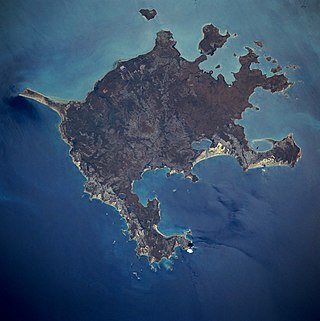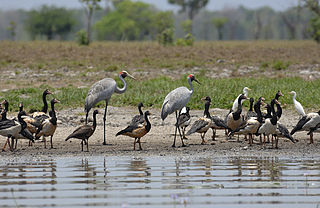Related Research Articles

The Northern Territory is an Australian internal territory in the central and central northern regions of Australia. The Northern Territory shares its borders with Western Australia to the west, South Australia to the south, and Queensland to the east. To the north, the territory looks out to the Timor Sea, the Arafura Sea and the Gulf of Carpentaria, including Western New Guinea and other islands of the Indonesian archipelago.

Groote Eylandt is the largest island in the Gulf of Carpentaria and the fourth largest island in Australia. It was named by the explorer Abel Tasman in 1644 and is Dutch for "Large Island" in archaic spelling. The modern Dutch spelling is Groot Eiland.

Arnhem Land is a historical region of the Northern Territory of Australia. It is located in the north-eastern corner of the territory and is around 500 km (310 mi) from the territorial capital, Darwin. In 1623, Dutch East India Company captain Willem Joosten van Colster sailed into the Gulf of Carpentaria and Cape Arnhem is named after his ship, the Arnhem, which itself was named after the city of Arnhem in the Netherlands.

The Aboriginal Land Rights Act 1976 (ALRA) is Australian federal government legislation that provides the basis upon which Aboriginal Australian people in the Northern Territory can claim rights to land based on traditional occupation. It was the first law by any Australian government that legally recognised the Aboriginal system of land ownership, and legislated the concept of inalienable freehold title, as such was a fundamental piece of social reform. Its long title is An Act providing for the granting of Traditional Aboriginal Land in the Northern Territory for the benefit of Aboriginals, and for other purposes.
The Central Land Council (CLC) is a land council that represents the Aboriginal peoples of the southern half of the Northern Territory of Australia (NT), predominantly with regard to land issues. it is one of four land councils in the Northern Territory, and covers the Central Australia region. The head office is located in Alice Springs.
The Northern Land Council (NLC) is a land council representing the Aboriginal peoples of the Top End of the Northern Territory of Australia, with its head office in Darwin.
The Garma Festival of Traditional Cultures (Garma) is Australia's largest Indigenous cultural gathering, taking place over four days each August in northeast Arnhem Land, in the Northern Territory, Australia. Hosted by the Yothu Yindi Foundation, Garma is a celebration of the cultural traditions of the Yolngu people, and a major community gathering for the clans and families of the Arnhem Land region. The event showcases traditional miny'tji (art), ancient story-telling, manikay (song), and bunggul (dance). It is held at Gulkula, a significant Gumatj ceremonial site about 40 kilometres (25 mi) from the township of Nhulunbuy, attracts more than 2500 guests each year and is often sold out months in advance.

Anindilyakwa is an Australian Aboriginal language spoken by the Anindilyakwa people on Groote Eylandt and Bickerton Island in the Gulf of Carpentaria in the Northern Territory of Australia. Anindilyakwa is a multiple-classifying prefixing language in which all traditional nouns, adjectives, personal and demonstrative pronouns are prefixed for person, number and gender. According to the 2021 Australian Census, Anindilyakwa was spoken natively by 1,516 people, an increase from 1,283 in 2006.
Angurugu is a community located on Groote Eylandt in the Northern Territory, Australia. The main spoken languages are Anindilyakwa, an Australian Aboriginal language, and English. Established as a Mission for the Church Mission Society, it is one of the three main indigenous settlements on the Groote Eylandt archipelago alongside Milyakburra and Umbakumba. According to the 2016 Census, the community had a population of 855, a decrease from 882 in 2006.

The East Arnhem Region is a local government area of the Northern Territory, Australia, governed by the East Arnhem Regional Council. Situated in the far north-eastern corner of the Northern Territory, the region covers an area of 33,310 square kilometres (12,861.06 sq mi) and had a population of approximately 10,345 in June 2018.
Land councils, also known as Aboriginal land councils, or land and sea councils, are Australian community organisations, generally organised by region, that are commonly formed to represent the Indigenous Australians who occupied their particular region before the arrival of European settlers. They have historically advocated for recognition of traditional land rights, and also for the rights of Indigenous people in other areas such as equal wages and adequate housing. Land councils are self-supporting, and not funded by state or federal taxes.
Aboriginal land councils in the Northern Territory are representative bodies known as land councils, covering four areas of Aboriginal self-governance in the Northern Territory of Australia.

Blue Mud Bay is a large, shallow, partly enclosed bay on the eastern coast of Arnhem Land, in the Northern Territory of Australia, facing Groote Eylandt on the western side of the Gulf of Carpentaria. It lies 580 km (360 mi) east-south-east of Darwin in the Arnhem Coast bioregion. Its name was given to a landmark court ruling affirming that the Aboriginal traditional owners of much of the Northern Territory's coastline have exclusive rights over commercial and recreational fishing in tidal waters overlying their land.
Alyangula is the largest township on Groote Eylandt in the Northern Territory.

The northern masked owl is a large forest owl in the family Tytonidae. The northern kimberli subspecies was identified as a novel race of the Australian masked owl by the Australian ornithologist Gregory Macalister Mathews in his 1912 reference list of Australian birds. The northern masked owl occurs in forest and woodland habitats in northern Australia, ranging from the northern Kimberley region to the northern mainland area of the Northern Territory and the western Gulf of Carpentaria. While the Australian masked owl is recognized as the largest species in the family Tytonidae, the northern masked owl is one of the smallest of the Australian masked owl subspecies.
Selena Jane Malijarri Uibo is an Aboriginal Australian politician. She has served as leader of the Labor Party and Leader of the Opposition in the Northern Territory since 3 September 2024, the first Aboriginal woman to lead a major political party in Australia. She is a Labor member of the Northern Territory Legislative Assembly since 2016, representing the electorate of Arnhem.

The Anindilyakwa people (Warnumamalya) are Aboriginal Australian people living on Groote Eylandt, Bickerton Island, and Woodah Island in the Gulf of Carpentaria in the Northern Territory of Australia.
Anne (Annie) Clarke is an Australian archaeologist and heritage specialist. She is a professor of archaeology and heritage at the University of Sydney. Clarke is a leading scholar in Australian archaeology, both historical and Aboriginal, as well as critical heritage studies. She has specialisms in archaeobotany, contact archaeology and rock art.
Umbakumba is a community located on Groote Eylandt in the Gulf of Carpentaria, Northern Territory, Australia. The main spoken languages are Anindilyakwa, an Australian Aboriginal language, and English. There are also several Yolŋu Matha speakers. It is one of the three main settlements on the Groote Eylandt archipelago, including Milyakburra and Angurugu, where Anindilyakwa is the predominant spoken language. According to the 2016 Australian Census, the population of Umbakumba was 503, an increase from 441 in 2011.
Anindilyakwa is a locality on Groote Eylandt, in the Northern Territory, Australia, located about 629 kilometres (391 mi) east of the territory capital of Darwin.
References
- ↑ "The Aboriginal Land Rights Act". Central Land Council. Retrieved 2024-09-11.
- ↑ "Aboriginal Land Rights (Northern Territory) Act 1976". Federal Register of Legislation. Australian Government. 16 Dec 1976. Retrieved 11 September 2024.
- ↑ "Transparency Portal". www.transparency.gov.au. Retrieved 2024-09-11.
- ↑ "About Us". Anindilyakwa Land Council. Retrieved 2024-09-11.
- ↑ "No exports from major NT mine for up to 12 months after cyclone damage". ABC News. 2024-04-22. Retrieved 2024-09-11.
- ↑ "Federal government freezes funding to NT land council as embattled chief executive flags resignation". ABC News. 2024-08-30. Retrieved 2024-09-11.
- ↑ Ben Abbatangelo, Rachel Hoffman (2024-07-20). "'Everything was going wrong': the white executive, the mine and the corruption referral". The Saturday Paper. Retrieved 2024-09-11.
- ↑ Brissenden, Neve (23 February 2024). "Groote Eylandt residents call for land council probe". National Indigenous Times. Retrieved 11 September 2024.
- ↑ "Land council boss accused of misusing millions referred to anti-corruption commission". ABC News. 2024-07-10. Retrieved 2024-09-11.